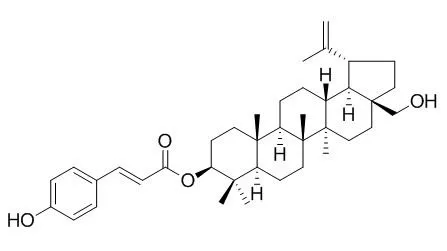METHODS AND RESULTS:
Primary screening of antitumor-promoting activity using soft agar colony assays with JB6 cells was employed to isolate 22 compounds from Chaenomeles sinensis KOEHNE. These compounds were lyoniresinol-2a-O-alpha-L-rhamnopyranoside (1), lyoniresinol-2a-O-beta-D-glucopyranoside (2), aviculin (3), betulinic acid (4), betulin (5), 3-O-(E)-p-Coumaroylbetulin (6), 3-O-(E)-caffeoylbetulin (7), 3-O-(Z)-p-coumaroylbetulin (8), 3-O-(E)-caffeoyllupeol (9), alphitolic acid (10), sorbikortal II (11), tormentic acid (12), euscaphic acid (13), corosolic acid (14), maslinic acid (15), erythrodiol (16), 1-beta-D-glucopyranosyloxy-3,4,5-trimethoxybenzene (17), avicularin (18), 7-O-beta-D-glucopyranosylkaempferol (19), 5-O-beta-D-glucopyranosylgenistein (20), 7-O-beta-D-glucopyranosylgenistein (21), epicatechin (22), and beta-sitosterol (23) and were identified using spectral data such as MS, (1)H- and (13)C-NMR.
CONCLUSIONS:
Compound 1, having a rhamnosyl group, showed greater activity than 2, having a glucosyl group, and 3, which was a bis-demethoxy derivative of 1. Betulinic acid (4), having a C-28 carboxyl group, 3-O-(E)-caffeoylbetulin (7), and tormentic acid (12) showed more potent activity than betulin (5), which has a C-28 hydroxymethyl group. |






 Cell. 2018 Jan 11;172(1-2):249-261.e12. doi: 10.1016/j.cell.2017.12.019.IF=36.216(2019)
Cell. 2018 Jan 11;172(1-2):249-261.e12. doi: 10.1016/j.cell.2017.12.019.IF=36.216(2019) Cell Metab. 2020 Mar 3;31(3):534-548.e5. doi: 10.1016/j.cmet.2020.01.002.IF=22.415(2019)
Cell Metab. 2020 Mar 3;31(3):534-548.e5. doi: 10.1016/j.cmet.2020.01.002.IF=22.415(2019) Mol Cell. 2017 Nov 16;68(4):673-685.e6. doi: 10.1016/j.molcel.2017.10.022.IF=14.548(2019)
Mol Cell. 2017 Nov 16;68(4):673-685.e6. doi: 10.1016/j.molcel.2017.10.022.IF=14.548(2019)